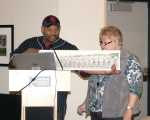Lecture presents links between Monarchs, Fort Scott

The Kansas City Monarchs were the focus of a lecture given by Phil Dixon sponsored by the Kansas Humanities Council at the Gordon Parks Museum inside the Danny and Willa Ellis Fine Arts Center at Fort Scott Community College Thursday afternoon.
Dixon, a co-founder of the Negro Leagues Baseball Museum in Kansas City, Mo., spoke as part of his series of "Kansas City Monarchs in Your Hometown"series. Before he began to speak, he donated to panoramic photo of a 1920s Monarchs team to the museum.
"This is my 137th or 38th city I've presented in in the last eight years," Dixon said. "Originally, I was just going to do 90 cities. But then I heard about (Sen.) Bob Dole going back to every county in Kansas and to personally thank people. And he's 90 and in a wheelchair now, so I figured I could do more. So you have Bob Dole to blame for me being here today."
The Monarchs, one of the best-known Negro League teams, had many players from Kansas and barnstormed often around the state, playing exhibition games against "town teams." The Monarchs played in Fort Scott at least nine times between 1922 and 1932. They won every time as part of a prolonged period in which they won 400 of 403 such exhibition games.
There were two instances in particular Dixon highlighted in his presentation. The first was a game held here on Oct. 10, 1922. The game featured a few Hall of Fame players but was noted for the fact that a Monarch pitcher, "China" Brown, was actually loaned to the local team. The Monarchs won just 3-2.
Another game highlighted was a Aug. 27, 1924 contest noted for the Fort Scott team bringing over a pitcher from Stockton, Mo., named Doc Steward. He left his practice for the day and struck out 12 Monarchs in a 3-0 loss. Six-hundred people were in attendance for that game.
The owners of the Monarchs J.L. Wilkinson and Tom Baird were the only white owners of a Negro League team. Wilkinson in particular was an innovator. He was the first owner of any sort of entertainment troupe, not just an athletic team, to purchase a bus rather than continue to take his team places on trains. This made some of their venues easier to get to and if there were no motels in the area that would allow the Monarchs to stay, the players could either sleep on the bus or pitch tents that they had packed.
Another innovation was night baseball. When Wilkinson heard about night football games being played at Haskell Institute in nearby Lawrence, he took the Monarchs there to test how well baseball would work under the lights. He was pleased with the results and began playing night games, even coming up with a way to bring portable lighting to the parks where they played exhibitions. Many towns in Kansas were hosting the Monarchs when the first night game was held in their community and Dixon feels that Fort Scott could have been a host to the Monarchs for the first game under the lights here.
The reason the Monarchs toured so much was a simple matter of economics, according to Dixon. He showed a copy of the Monarchs' accounting book from their 1923 tour. They made $518 for a game in Pittsburg one day and $271 for a game in Fort Scott the next. And if the Monarchs could promise a star pitcher would play on a given night, they could make even more money. But later in the year, a series of games against a Cuban team played in Kansas City had a fairly high total for one game but declined after that to the point where the last of the five games brought in just $66.
Wilkinson was a pioneer for equality in baseball, according to Dixon. He founded a team called the Bloomer Girls to give women a chance to play baseball. This was well before the All-American Girls Baseball League existed during World War II.
Wilkinson also created the "All-Nations" team because he wanted to have a team with all nationalities. This team, which signed the first Japanese professional player in 1914, made a stop in Fort Scott in 1917.
Ironically, although Baird was responsible in at least some part for signing players such as Buck O'Neill and Ernie Banks, an investigation authorized by then Kansas Governor Henry J.Allen following information that the Ku Klux Klan had infiltrated the state revealed that Baird was one of over 1,000 members of the Klan in Kansas City, Kan., alone. Dixon revealed in his lecture that he visited Baird's daughter and persuaded her to donate Baird's baseball memorabilia to a museum in Lawrence.
The lecture concluded with a brief question-and-answer session.
